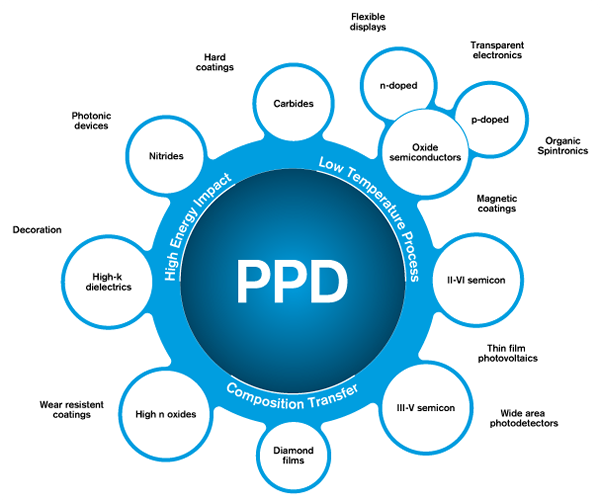Applications
PPD Applications
The applications of PPD systems are metals, oxides and compound semiconductors; high dielectric constant thin films; buffer layers; hard coatings (diamond-like carbon [DLC], carbides, and nitrides), transparent conducting oxides (TCO); ultrahigh-temperature coatings; high-temperature superconductors; teflon; decorative coatings; biocompatible coatings, and single wall carbon nanotubes.
NEW TCO on PET
The unique characteristics of the PPD is the ability to transfer the chemical composition of the target to the film and in this way the most complex thin films may be fabricated.
In addition, the temperatures needed to deposit thin films by the PPD are considerably lower than those of the ordinary method making it possible to deposit on ordinary plastic substrates such as polyethylene terephthalate (PET).

Thin films made by the PPD
- Transparent Conducting Oxides (TCO) (ITO, IMO, ZnO, etc.)
- Multi layer thin film solar cells (CdS, CdTe, Sb2Te3, CuInSe2, etc.)
- High TC superconductors (YBCO ,TC > 92K, IC = 2-4*106 A/cm2)
- CMR manganites (TC = 350 K, 100% spin polarized at room temperature)
- Ultra high k dielectrics (BST, STO, etc.)
- Buffer layers (AlOx, TiOx, CeOx, ZrOx, BaF2, etc.)
- High bandgap transparent materials (SiOx,etc )
- High bandgap semiconductors (GaN, etc.)
- Biocompatible materials (quaternary SiOx- CaO- PxO5- Na2O system)
- Organic materials (teflon, polyethylene, etc.)
- Hard and wear resistant coatings (SiC, TiN, Diamont like carbon, etc.)
Download Literature References